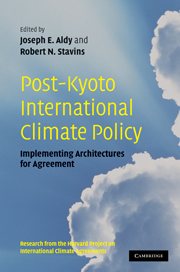Book contents
- Frontmatter
- Contents
- Harvard Environmental Economics Program, International Advisory Board
- Harvard Project on International Climate Agreements, Faculty Steering Committee
- Harvard Project on International Climate Agreements, Project Management
- List of figures
- List of tables
- List of contributors
- Foreword
- 1 Introduction
- Part I Alternative international policy architectures
- Part II Negotiation, assessment, and compliance
- Part III The role and means of technology transfer
- Part IV Global climate policy and international trade
- Part V Economic development, adaptation, and deforestation
- 18 Reconciling human development and climate protection: a multistage hybrid climate policy architecture
- 19 What do we expect from an international climate agreement? A perspective from a low-income country
- 20 Climate accession deals: new strategies for taming growth of greenhouse gases in developing countries
- 21 Policies for developing country engagement
- 22 International forest carbon sequestration in a post-Kyoto agreement
- Part VI Modeling impacts of alternative allocations of responsibility
- Part VII Synthesis and conclusion
- Appendix A Selected List of Individuals Consulted, Harvard Project on International Climate Agreements
- Appendix B Workshops and Conferences, Harvard Project on International Climate Agreements
- Glossary and Abbreviations
- Index
22 - International forest carbon sequestration in a post-Kyoto agreement
Published online by Cambridge University Press: 05 June 2012
- Frontmatter
- Contents
- Harvard Environmental Economics Program, International Advisory Board
- Harvard Project on International Climate Agreements, Faculty Steering Committee
- Harvard Project on International Climate Agreements, Project Management
- List of figures
- List of tables
- List of contributors
- Foreword
- 1 Introduction
- Part I Alternative international policy architectures
- Part II Negotiation, assessment, and compliance
- Part III The role and means of technology transfer
- Part IV Global climate policy and international trade
- Part V Economic development, adaptation, and deforestation
- 18 Reconciling human development and climate protection: a multistage hybrid climate policy architecture
- 19 What do we expect from an international climate agreement? A perspective from a low-income country
- 20 Climate accession deals: new strategies for taming growth of greenhouse gases in developing countries
- 21 Policies for developing country engagement
- 22 International forest carbon sequestration in a post-Kyoto agreement
- Part VI Modeling impacts of alternative allocations of responsibility
- Part VII Synthesis and conclusion
- Appendix A Selected List of Individuals Consulted, Harvard Project on International Climate Agreements
- Appendix B Workshops and Conferences, Harvard Project on International Climate Agreements
- Glossary and Abbreviations
- Index
Summary
Introduction
Forest carbon management must be an important element of any international agreement on climate change. Forest carbon flows comprise a significant part of overall global greenhouse gas (GHG) emissions. While global forests as a whole may be a net sink (Nabours and Masera 2007), global emissions from deforestation contribute between 20 and 25 percent of all GHG emissions (Sedjo and Sohngen 2007, Skutsch et al. 2007). The size of the total global carbon pool in forest vegetation has been estimated at 359 gigatonnes of carbon (GtC), which compares to annual global carbon emissions from industrial sources of approximately 6.3 GtC (IPCC 2000). The potential impact on the global carbon cycle of both natural and anthropogenic changes in forests is enormous.
An effective international forest carbon management regime must not only provide landowners and governments with incentives to protect and expand stocks of carbon, but must induce countries to enroll in the forest agreement in the first place. Ideally, a multilateral forest carbon program would also impose relatively low transaction costs even as it encourages decision makers to seek low-cost opportunities for sequestration.
The current international regime, the Kyoto Protocol, has proven ineffective in this regard. There are three primary problems. First, the Annex I (industrialized) countries are required to include afforestation, reforestation, and deforestation in their national accounting. However, Article 3.3 of the Kyoto Protocol limits that accounting to changes that are “human-induced,” inviting endless arguments about which changes should be included. For example, one can make reasonable arguments both for and against, say, Canada's inclusion of continued northern forest growth as a “human-induced” change in its national carbon account.
- Type
- Chapter
- Information
- Post-Kyoto International Climate PolicyImplementing Architectures for Agreement, pp. 682 - 712Publisher: Cambridge University PressPrint publication year: 2009
- 6
- Cited by



